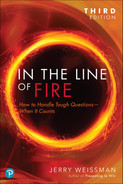Introduction to the Third Edition
Universal Challenges, Universal Solutions
What’s past is prologue.1
The Tempest
William Shakespeare
This book, together with Presenting to Win: The Art of Telling Your Story and Designing Your Slides and The Power Presenter: Techniques, Style, and Strategy to Be Suasive, the other two books in this trilogy, culminates a complete foundational methodology to master all the essential skills in any presentation. Readers of the first two books will be familiar with the concept of Audience Advocacy®, the overarching principle that presenters must advocate their audience’s interests as much as—if not more than—their own, a viewpoint that applies to all the essential elements of any presentation:
Rather than tell a story that is a laundry list recitation of the presenter’s attributes, every step of the clear, crisp narrative must be meaningful to the audience.
Rather than design slides that serve as standalone handouts, every image must serve only to illustrate the story for the audience.
Rather than succumb to the universal fear of public speaking, the presenter must demonstrate confidence to the audience when delivering the story.
And so here, with the focus on handling tough questions, rather than slip, slide, and spin as politicians do, every presenter must answer every question the audience asks—to their satisfaction.
In the first two editions of this book, I presented the core techniques of the Suasive methodology to handle tough questions and illustrated them with examples drawn from the presidential debates of the 2000/2004 and 2008/2012 election campaigns, respectively. For this edition, I’ve replaced the political examples with an entirely new set of case studies drawn from the business world—in particular, from the thousands of IPO roadshows and pitches for private financing that I have coached. You’ll also find many new case studies of CEOs in other types of Q&A sessions—industry conferences, media interviews, and quarterly earnings calls—for the simple reason that these events, being public, were readily available for my research. However, I can assure you that every businessperson, from the most senior vice president to the newest intern, encounters the same dynamics and needs the same techniques to respond to tough questions as does every CEO. For all of them and for you, the fundamental concepts of the Suasive techniques, with some streamlining and new content, are essentially the same as in the previous editions—attesting to their enduring applicability.
Three political case studies remain: one of The Great Communicator, Ronald Reagan; one from the historic debate between John F. Kennedy and Richard M. Nixon; and another from a pivotal moment in a 1992 presidential debate. The latter two resulted in dramatic turnarounds, vividly demonstrating that how candidates handle tough questions in the highest of high-stakes exchanges has a direct impact on their immediate and ultimate fortunes.
Although the political arena has its own rules and peculiarities that set it apart from most other arenas of life, how all people handle every challenging exchange has an impact on their immediate and ultimate fortunes—whether in business, science, academia, government, philanthropy, job interviews, or even interpersonal relationships. My intent in casting this wide net is to help you understand the universal dynamics of every human exchange.
I’ve delivered these universal solutions in the boardrooms of some of America’s most prestigious corporations and in the conference rooms of the hottest startups around the globe—Silicon Valley, New York, London, Paris, Milan, Bangalore, Jerusalem, Beijing, and Singapore—to the C-level teams of the more than 600 companies I’ve coached for their IPO roadshows, among them Cisco, Intuit, Dolby Labs, eBay, Netflix, Yahoo!, RingCentral, Twilio, Trulia, Talend, Mobileye, Zuora, Freshworks, Sonos, and Lyft. I’ve also provided the same techniques to thousands of presenters at all levels of management who have had to field tough questions when they pitched to raise private capital, launch products, raise sales quotas, publicize a press release, form a partnership, requisition head count, or solicit approval of a budget.
The techniques are now yours to learn and deploy so that you can Be Suasive, Be Heard.
■ Book Conventions ■
![]()
Throughout the book, you’ll see this icon, which indicates video and audio files referenced as examples. We provide the original sources for all videos and audio for you to access on your own. All the video references are listed in Appendix A. To view select video and audio files, please visit our website, at suasive.com/videos.
